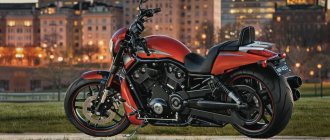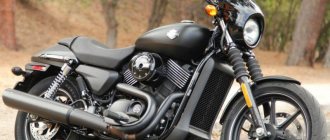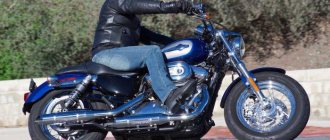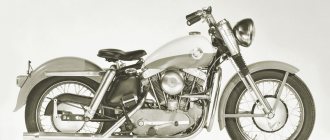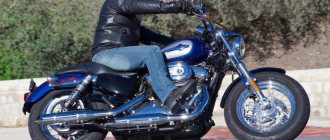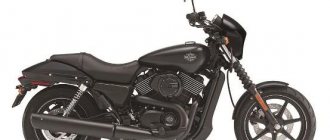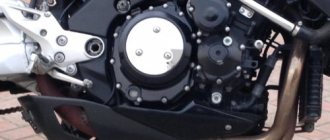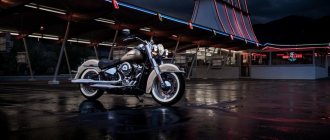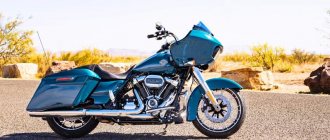Technical characteristics of Harley Davidson Road King Classic
| Engine volume, cm3 | 1690 |
| Power, hp | 86 |
| Number of cylinders | 2 |
| Number of cycles | 4 |
| Maximum speed, km/h | 165 |
| Gasoline consumption, l | 5,6 |
| Tank volume, l | 22,7 |
| Transmission | 6-speed |
| Seat height, mm | 678 |
| Weight, kg | 367 |
The two-cylinder v-twin engine has remained virtually unchanged since the model was launched. The engine is easy to maintain. The main elements of the system can be easily removed without disassembling half the motorcycle or removing the engine from the frame. A low degree of forcing is applied. Each cylinder has two valves. The cooling system is air. The fuel supply is regulated by the carburetor.
The Harley Davidson Road King engine is mounted on rubber mounts, so slight vibrations may be observed after starting. The advantage of this mounting system is that at any speed the engine does not bother with vibration. The engine has good traction at low speeds, but at high speeds it lacks power.
Gear shifting is harsh. In addition, it can be difficult to catch neutral. The programs themselves are quite long. The gearbox fully matches the characteristics of the motor, if you do not require high speed acceleration dynamics.
The robust duplex frame and reliable suspension ensure high riding comfort. The front suspension is a conventional telescopic fork with 117 mm of travel. The rear suspension is a pendulum with two shock absorbers. The suspension handles road unevenness quite well, which is also facilitated by the heavy weight of the motorcycle.
The braking system is reliable and predictable, but it is not powerful enough for the weight of the motorcycle. Brakes – disc, hydraulic. The front brake consists of two discs with two single-piston calipers. The rear uses one disc. Riding safety is enhanced by using the ABS system. Uninterrupted control of the braking system is provided electronically.
I was recently in the States, in California. I rode with friends along the local serpentines in the Sierra Nevada mountains, wandered around Yosemite Park and Sequoia Park - this is a must see, of course... If you are interested, I will write separately about the parks. Well, I looked around to see what people were driving. It’s as if Harley-Davidson didn’t tell the Americans that the company has other models besides the Electric Train and the Road King - these two motorcycles dominate the traffic so much over all the others.
In our country, Road King is not so common, but it’s a pity - he’s a handsome guy!
Moreover, he was born in 1993 without any radical changes in appearance and lived until 2017.
1993
2022
Would you say it's boring? And we, Harley lovers, let’s say - classics, traditions and that’s all we like about HD :) And these are not just words.
In addition to the name, all Harley-Davidson models have a letter designation - the Road King has FLHR. It sounds almost like the name of items from IKEA and few people understand. However, using these letters you can trace the history of the model or simply understand where the wheels come from. Although sometimes in the . Thus, the first FL models, which means large-frame, appeared in 1941. They were equipped with a Knucklehead 74 engine (1210 cm3). In 1948, the engine was replaced with a Panhead of the same displacement.
In 1949, the company installed its first hydraulic telescopic fork on the FL, which is reflected in the name - FL Hydra-Glide. What makes it difficult to understand is that the name Glide was used not only for FL... Well, yes, for that time some confusion is forgivable :)
But the letter H appeared in the model name later, when in 1955 the motorcycle received a more powerful engine with a higher compression ratio (H - high compression). In 1958, the FLH was equipped with rear brakes and rear hydraulic suspension, and the name was changed to Duo-Glide.
In 1965, the legendary “Electric Train” appeared - FLH Electra-Glide, where Electra simply means replacing the kick starter with an electric starter.
The FLH branch split in 1977 when the already popular Electra-Glide was joined by the cheaper FLHS Electra-Glide Sport, which did not have a full-length fairing. The first FLHS Electra-Glide Sport “came to rest” in 1982, but five years later, in 1987, it was revived, again “half-naked,” based on the FLHT Electra-Glide, which, in turn, was based on more a massive and long touring frame from the FLT Tour Glide, where T = Tour (yes, you can’t figure it out without a glass of tea!) and a 1340 cc Evolution engine mated to a 5-speed gearbox.
And then in 1993 (1994 model year), our hero, the FLHR Road King, appeared to replace the now completely gone Electra-Glide Sport. Like its predecessor, the “King of the Road” had hard side panniers and a huge windshield, but did not have any fairings, i.e. the king, one might say, was (and is) naked! Well, then he gradually increased the “fat” - the engines successively replaced each other in the direction of increasing volume: first the 1340 cc Evolution, then the 1450 cc Twin Cam 88 (1999), then the 1584 cc Twin Cam 96 (2007) , 1690 Twin Cam 103 (2012) - and this year 1745 cm3 and 150 Nm of the new Milwaukee-Eight 107 engine (I wrote about it here).
2010
2011
2012
2013 Anniversary Edition.
Since then, the appearance of the device has not changed radically, and changes in the chassis and body kit took place gradually, keeping up with the times, as they say, and not very noticeable to an untrained person.
In 2014, the Road King received a more powerful High Output Twin Cam 103 engine, a bright twin halogen lamp in the classic chrome Hiawatha headlight, halogen foglights, new Impeller wheels, new hard cases that can (yay!) be opened and closed with one hand, and new ABS.
2015
2016
And in 2022, all HD touring cars received new suspensions: a new Showa fork and rear shock absorbers with an increased range of spring preload adjustment using a lever, without tools.
The Road King has a lot of chrome and large iron parts - just like they liked to do in America in the 1960s.
From year to year, the asphalt of the highways in front of the “King of the Road” is illuminated by a large chrome headlight, which, by the way, has its own name - Hiawatha. I always thought it was something from Indian mythology. It turned out to be almost right - there was a mistake in one letter: not Indian, but Indian :) The Iroquois had such a leader, Hiawatha, who united several tribes into a confederation. Almost a national hero.
Sculpture of Hiawatha in Irowood.
The Road King has everything within the genre: saddlebags (leather for the RK Classic, plastic for the regular one), a tall windshield, a wide seat... Not the Electra Glide, of course, but more versatile: it’s good both in the city and outside the city.
For the police.
Firefighter. This version had no special features, just a unique design, and was sold exclusively to current or former fire service personnel and emergency responders.
Hearses...
The Road King, like many other Harley-Davidson models, has been featured in films. Not as cult as “Terminator”, of course, but also famous: “The Jackal” (1997), Deja Vu (2006), Marley and Me (2008), in the disaster film “2012” (2009) and some others; in the series "24 Hours" and "Six Feet Under", and in "Sons of Anarchy" Piney, Red's father, rode a trike based on the Road King.
In general, today the Road King remains the king of the road: big, heavy, chromed everywhere, stylish and unchanged... Long live the King, as they say.
Advantages of the model
- The powerful, reliable engine is easy to maintain.
- The motor is mounted on a rubber cushion, which minimizes vibration at any speed.
- The braking system is equipped with ABS.
- Comfortable fit.
- Spacious trunks.
- The low center of gravity ensures good handling at speed.
- Cruise control.
- Good wind and mud protection.
- The heavy weight minimizes the influence of crosswinds.
- Full-length driver and passenger footrests, the height of which can be adjusted.
motorcycle strangers
Adapted translation of an article from https://www.american-v.co.uk
Injection engines in the Harley line appeared first as an option, and then replaced carburetors... which gave rise to battles with lovers of traditions. This article compares 2 almost identical motorcycles - Harley-Davidson FLHRCI Road King Classic 2001 and Harley Davidson FLHR Road King 2001, both have the same Twin Cam 88A engines, have the same frames, dimensions, weight, etc. The only difference is that the Road King Classic is fuel-injected, while the Road King is equipped with a Keihin CV40. Plus they have different cases and prices. While the price comparison is fairly easy - a £1,000 difference - the panniers and fuel system are not so easy. The comparison does not include such little things as steering wheels, saddles, color and other little things. Let's start with the cases - which is better, plastic or leather? Personally, I'm all for plastic: they're more comfortable, they lock and fit better...brings back memories of my old Electra Showelhead. I love leather bags, it would be rude of me to disparage them...but they get wet more, are less tamper-proof and are a little more difficult to use due to the hassle of straps. Want more detailed explanations? The leather is good when dry, but moisture...the leather gets wet, allows water to pass through to the contents of the panniers and takes a long time to dry. Trying to dry your skin quickly will lead to problems later.
Safety. It's no secret that opening leather bags will not be difficult, unless they are equipped with locks. By the way, locks can become a problem after a cold trip - both the locks that close the panniers and the locks that hold the panniers. There is more fuss with leather bags, because when you arrive at your rest stop, you will want to take out the contents of the bags and take them to your room/tent. If you don’t have a tour pack in the form of an internal bag, this can become a problem: imagine this: you take something out of the depths of the case with one hand, and with the other you hold the lid of the case and all the rest of your belongings, tied with rubber bands around. By the way, about other belongings - many plastic trunks have a more even and comfortable platform on top; catalogs have tuning in the form of frames. This makes it much easier to secure luggage from above.
If the same arguments are applied to the softail, then leather bags will certainly win: such a motorcycle in the style of the naive 60s, space age and Flash Gordon may be inappropriate. The leather saddlebags are complemented well by the 1960s headlight that appeared on the first FLT tourers and was reborn on the Road King. The lines of the leather bags go better with the dry frame, in my opinion. The fuel system is even more subjective. There are many people for whom a carburetor is the only option. The abundance of tuning, ready-made carburetors and accessories makes it easy to change the mixture preparation beyond recognition. For a long time, the behavior of the carburetor has not been recorded and implemented in a chip with fuel maps. The problem is that there are few people who know why certain carburetors perform well in terms of fuel delivery throughout the entire rpm range, and even fewer people who can write this into a chip and give the injector similar properties. This need arose due to requirements for environmentally friendly exhaust, the general struggle for fuel economy and other legislative initiatives. But tuning the injector makes it possible to change the ignition timing curve and change the fuel map. That is, you can add torque, make the engine more economical, or vice versa - “fuck fuel econony” and burn it out on the weekend.
Injection systems have been used on cars for a long time and they just needed to be adapted for motorcycles. Let's get back to basics. While installing Stage One in a carburetor is quite simple, it won’t be so easy with an injector. For EFI, you need to reflash the “brains”, i.e. record a new fuel map configured for a specific engine and specific intake and exhaust. This operation requires a special computer with special software. The most common way is to install power commander. However, keep in mind that installing a Mikuni carburetor or jet-kit for a stock Keihin will give more performance, because even a re-flashed injector will be “strangled” by environmental requirements. In stock, the injector makes cold starting much easier, but requires more attention and discipline, because the engine still needs to be warmed up, especially such a big one like TwinCam. A stock carb will give you unforgettable minutes that feel like hours as you sit and warm up, but no stock bike is Stage One equipped, so you'll have to be patient. In all cases, I let the engine warm up properly, because I don't want to hear "pppppphhhhhhhhhhhhhhhhhhhhhhhhhhhhhhhhhhhhhhhhhhhhhhhhhhhhhhhhhhhhhhhhhhh way out of the carburetor for a while, like when overtaking." I also ride a mile or two on my bikes to give the asthmatic and old filter air cavity a breather. If your carburetor is "charged", you will get an increase of about 10 hp and 20 lbs of torque.
Another argument of carburetor supporters is roadside maintainability. If the carburetor starts acting up on the way home, you can see it by the clouds of smoke coming from the exhaust pipe. The injector will not do this; you will only notice a drop in power. Similar argument - a friend of mine switched to a chain drive instead of a belt drive because it was easier to fix on the Australian roadside. However, when it comes to tuning and oldschool, there's nothing stopping you from leaving the electronic ignition and kickstarting. If there is a fuel filter and you use high-quality gasoline, then the carburetor works flawlessly. The injection system contains significantly more components, such as a pump, various sensors on the intake and exhaust tracts and an electronic unit that controls the injectors. One way or another, some nodes may fail. A clogged carburetor will allow you to get to the garage, but a failure of one of the injector units will leave you on the side of the road. Price. What makes a thousand pound bikes different is the panniers + fuel system. The type of engine often plays a role, but in this case they are the same - black crankcase and chrome covers. You shouldn’t focus on nameplates and other little things. Color options are very subjective, the only difference in the seats that I could find was that on the Classic they were hotter after being parked in the sun. In terms of comfort, they are absolutely the same. The handlebars look the same, but the handlebars on the FLHR hit my knees in the extreme position.
Source
Disadvantages of the model
- Oil must be poured separately into the engine, primary gear and gearbox.
- Quite a lot of oil consumption.
- Heavy weight.
- There is no tachometer and light flashing button.
- The head light is weak.
- The control indicators are practically invisible during the daytime.
The Harley davidson road king classic motorcycle is suitable for long trips, which is facilitated by a comfortable seat, reliable wind protection, a good power reserve and spacious trunks. In the city, control becomes somewhat more complicated, since the motorcycle is not small in size, and it is not distinguished by sufficient maneuverability. The motorcycle demonstrates all its power and strength on country roads.
Reliability, solidity, good handling increases the level of confidence in control and driving safety. The simplicity of the design not only makes it easy for a person who is not used to understanding the technical part to understand the motorcycle on their own, but is also considered an advantage when troubleshooting problems on the road.
Test drive Harley Davidson CVO Road King. Two-Faced King
Harley Davidson is the company that all motorcycle manufacturers in the chopper, cruiser and touring classes look up to. When they say “a motorcycle is made in the American style,” they mean Harley Davidson. For those who are familiar with the brand only through such stamps, it will be interesting to take a closer look at the company’s model line.
Sportster. Small, nimble bikes for the city. They are inexpensive, weigh little, and are easy to operate. Suitable for both beginner riders and experienced motorcyclists.
Harley Davidson 883 Roadster
The second line is the Dyna . Motorcycles for dynamic riding, the design of which is made in a minimalist style.
Harley Davidson Dyna Street Boob
Softail family is a classic, with a sprung triangular swingarm. Unlike motorcycles with a rigid frame such as hardtail, the softail has rear suspension, only the shock absorbers are hidden under the body of the motorcycle.
Harley Davidson Softail Fat Boy
V-rod family has an original appearance, a powerful engine developed jointly with Porsche engineers, a wide rear wheel, and contrasting colors. Harley Davidson was able to expand its audience due to the influx of new customers - young people.
Harley Davidson Night Rod Special
And finally, the Touring . These are motorcycles designed for travel, consuming thousands of kilometers. Comfortable seats, comfortable suspension settings, cruise control, audio system, excellent wind protection - you can drive endlessly, regularly stopping at gas stations.
Harley Davidson Road King Classic
Motorcycles assembled in a factory tuning studio stand apart - models with the prefix CVO in the name. They are more powerful than production bikes, and have a modified engine (the intake and exhaust have been changed). Motorcycles are assembled and painted by hand. Additionally, their color schemes are not used on other models. Motorcycles are assembled in small batches, and one of these came to me for a test drive. Meet the Harley Davidson CVO Road King 2014.
Harley Davidson CVO Road King
The motorcycle is equipped with a Twin Cam 110 engine (torque 160 Nm), which is mated to a 6-speed gearbox. But the main thing here is not the “car” torque, but the ability to remove the windshield in one motion, thereby giving the motorcycle a retro “dieselpunk” look: the headlight, fairing, rear fender and the shape of the panniers - all of this immerses us in the 30-40s of the last century . Incredible! If you look from the front, it seems that there is a locomotive in front of you.
As for the weight and dimensions, they are quite consistent with mine (height 192, weight 125). The motorcycle itself weighs about 380 kilograms. This is the normal weight of an iron “cruiser”.
The controls here are standard, but I didn’t immediately find the button for switching operating modes of the on-board computer. It is hidden under the back of the remote control. The “foot” of the rear brake is located quite high: on the one hand it is convenient (you can normally place your foot on the platform), but on the other hand you need to raise and straighten your foot to brake. The gear selector is easy and convenient to use, but you can’t change speeds with the toe of your boot - it doesn’t fit under the “foot.”
Well, enough looking and trying on, it’s time to go. I turn on the ignition and the dashboard flashes red. The backlight is somewhat unusual in color, and the panel itself is different from the usual one.
The revving Twin Cam 110 engine fills the garage with a pleasant purr. But damn it, why is it so quiet? Probably, Russian certification requirements prevent the installation of mufflers on a motorcycle that would produce a normal sound. Now you can only hear a huge zero-impedance filter.
I drive out onto the road, unscrew the handle... it really is a locomotive. It pulls from the very bottom and continues to pull throughout the entire rev range. It seems that the Road King picks up speed instantly. I’m a cultured driver, I don’t exceed speeds of more than 20 km/h, so I have to pull myself together all the time.
The brakes are equipped with an electronic brake force distribution system, and from a speed of 40 km/h, no matter which brake you press, the system itself selects which circuit to apply what force.
The engine growls. The wind blows on your face, freedom! And there's traffic on you, and keeping the Road King at low speeds turned out to be not the easiest task. I had to constantly hold the motorcycle with the rear brake - it kept trying to go off the line and into the nearest car.
The only way to move between rows is in a zigzag (the editors of Turboanimals condemn the inter-row driving style). The wide panniers also get in the way. The element of Road King is the free road. You set the cruise control and off you go. To Ryazan, for example, to the Ryazan Kremlin.
My wife and I set off towards Ryazan early in the morning. The temperature was about 3-4 degrees Celsius, the weather was sunny, but at the same time, I was a little frozen, and my wife, on the contrary, forbade me - I blocked her from the wind almost completely with my powerful body.
As soon as we felt the spirit of freedom, in the very first traffic light jam the problem of the motorcycle’s stability at low speeds revealed itself: if without a passenger the bike swayed only a little, then with a passenger the vibrations acquired a critical amplitude. It’s good that I’m in excellent shape, otherwise I would definitely have “decayed”.
After 50 kilometers, my wife started knocking on the helmet, asking to stop. There is no back - my back is numb. All. After that, the road became torment for both. We had to drive in segments of 30-50 kilometers: neither increasing the speed nor any other tricks helped. There was even an idea to buy a tourist inflatable pillow for the “fifth point” in Ryazan. It was not so comfortable to travel on this motorcycle, especially with two people.
What is the result? Harley Davidson CVO Road King is not a motorcycle for every day - it is a weekend bike for easy walks on a fine summer day; You can “pull” on it and drive up pretentiously. It will decorate your collection.
We recommend reading
- A second car as a sign of the middle class Analysts from the Autostat agency conducted a study in September of this year, the purpose of which was to find out how many cars there are…
- Harley-Davidson Tri Glide: just for fun During the entire test, I was asked several times if this was the same Harley that was in the Comedy Club. Damn guys, I...
- Harley Davidson Street 750 The Harley Davidson company presented a new Street 750 motorcycle in Russia. The model was primarily created to attract young…
